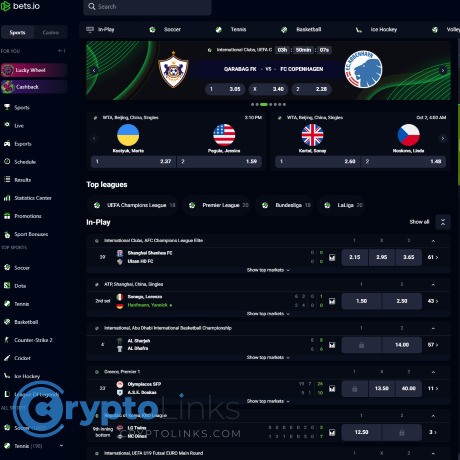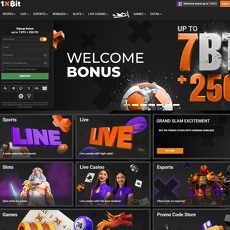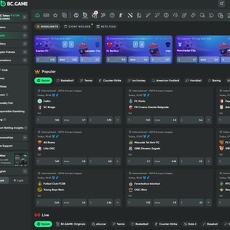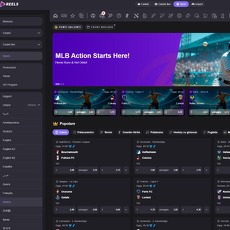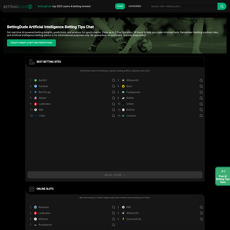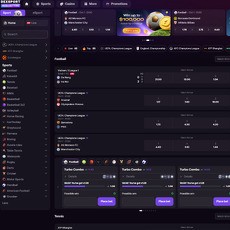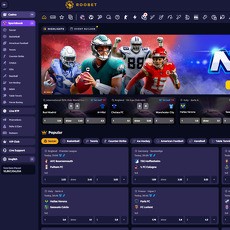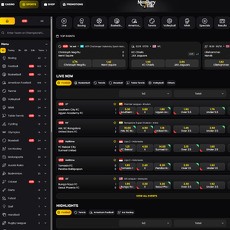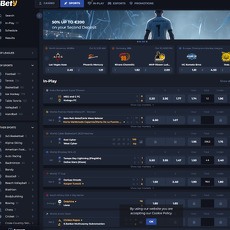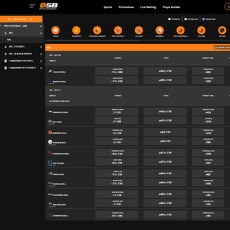Bets.io Review
Bets.io
bets.io
Bets.io Sports Betting: The Ultimate Review Guide + FAQ — with Sportsbet.io Questions Answered
Thinking about sending crypto into Bets.io Sports but not sure if it’s worth your time—or if you should be using Sportsbet.io instead? You’re not alone. Names sound alike, terms can be vague, and the last thing you want is a stuck withdrawal or a promo that looks “free” but eats your bankroll.
“Confusion is expensive; clarity is free—at least before you deposit.”
Here, I keep things simple: what works, what doesn’t, and how to get the best value without nasty surprises.
What’s frustrating right now (and why you’re right to be cautious)
Most readers hit the same roadblocks when they compare crypto sportsbooks, especially when names overlap:
- Brand confusion: Bets.io Sports vs Sportsbet.io. Similar names, different sites. You look up one, get FAQs for the other.
- Legitimacy questions: Is Bets.io Sports actually safe? Where’s it licensed? How do you verify that quickly without a legal degree?
- Money mechanics: What are the real minimum deposits? How do withdrawals work step-by-step? What triggers KYC and delays?
- Betting basics: What does a +7 spread actually mean for your payout? When is it a push vs a loss?
- Fine print traps: “Free bet” promos with odds restrictions, rollover you didn’t expect, or currencies that don’t qualify.
- Time and risk: Slow payouts, surprise compliance checks, or sending crypto to the wrong network because the page wasn’t clear.
These aren’t edge cases—they’re the stuff that costs people money and patience every week.
What I’ll do for you (so you don’t learn the hard way)
I’ll give you a clean, actionable breakdown. No fluff, no guessing. You’ll see:
- Licensing and safety: What exists now and how to verify it yourself in under two minutes.
- Account and payments: How sign-up works, when KYC might pop up, and how to avoid withdrawal delays.
- Bonuses with real math: What’s on the page, what the rollover actually costs, and when to skip.
- Betting features that matter: Odds, markets, live tools, and whether cash out is worth leaning on.
- Plain-English betting help: How spreads like +7 grade, simple bankroll tips, and how to avoid rookie mistakes.
- Quick-hit FAQ: Including the Sportsbet.io questions you keep seeing when you search for Bets.io.
By the end, you’ll have clarity, a plan, and zero fear of “hidden” steps. That’s the whole point.
What’s coming next (and how it helps you right now)
- Brand clarity: Bets.io Sports vs Sportsbet.io — different platforms, different promos, similar names.
- Safety you can check: License status, site security, fairness signals, and reputation patterns.
- Deposits and withdrawals: Supported coins, networks, limits, fees, and realistic payout speed.
- Bonuses and value: When to opt in, when to pass, and how to spot “free” offers that aren’t.
- Odds and markets: Sports, eSports, live betting tools, and the mobile flow for quick bets.
- Education that saves money: +7 spread explained simply, bankroll basics, and crypto-specific tips.
- FAQ with sourced answers: Including minimum deposits, withdrawal how-tos, and push rules on spreads.
Ready to cut through the noise? Up next, I’ll show you what Bets.io Sports actually looks like at a glance—and clear up the Sportsbet.io name mix-up that’s causing most of the confusion. Curious which one fits you best before you even sign up?
Bets.io Sports at a glance (and the Sportsbet.io name mix-up)
If you’re crypto-first and you want a sportsbook that just gets out of your way, Bets.io Sports feels built for that. It’s fast, clean, and familiar if you’ve used modern books before. The naming curveball is real though: plenty of people type “bets io sports” and end up reading FAQs for Sportsbet.io. Similar names, different homes.
“Clarity beats luck: the book you understand is the book you beat.”
Quick snapshot of Bets.io Sports
Here’s the quick-hit view of what you can expect right now:
- Coverage: Big-league staples like football/soccer, basketball, tennis, MMA, ice hockey, and cricket; plus eSports such as CS2, Dota 2, League of Legends, and Valorant. Expect popular props (totals, handicaps, player markets) on headline events, with thinner depth on obscure leagues.
- Live betting: In-play odds update quickly with the usual lockouts during key moments. Cash Out is available on selected markets, often with both full and partial options when liquidity cooperates.
- Odds formats: Switch between Decimal, American, and often Fractional in one click. If you line-shop, that saves a ton of mental math.
- Crypto support: Major coins are on tap — think BTC, ETH, and USDT at minimum — with several others typically available. It’s crypto in, crypto out; no card details needed.
- Promos: Rotating deals like odds boosts, free bets, and multi-bet (acca) perks are common. Always check eligible odds and rollover before you click “opt in.”
- Standout feel: Minimalist interface, fast bet slip, and a shared wallet with the casino if you’re already playing there.
- Potential deal-breakers: Streaming is hit-or-miss on niche events; smaller-market depth can lag the big-name books; restricted regions apply; and KYC can trigger at higher withdrawal thresholds (I’ll explain how to avoid speed bumps soon).
Example flow most bettors care about: you see a Premier League total at 2.5, odds drift from 1.90 to 1.95 in-play, you tap once, confirm, and the slip is settled. If the game swings, Cash Out might pop with a small profit — that’s the rhythm Bets.io seems to optimize for.
Bets.io vs Sportsbet.io: different brands, similar names
Let’s clear the fog:
- Different URLs, different terms:Bets.io Sports and Sportsbet.io are separate platforms with their own promos, rules, and support teams.
- Why the mix-up? Search engines often autocomplete “bets io sports” into “sportsbet io,” and comparison sites sometimes mash the names together. That’s how users end up reading the wrong FAQ.
- Product personality: Bets.io is crypto-first and streamlined. Sportsbet.io is a long-running brand with broader regional promos and, in some markets, extras like more frequent boosts or event streams.
- Licensing footprints: Both operate under their own licenses and compliance playbooks. The specifics matter for your peace of mind — I’ll show you how to verify them yourself in a moment.
Bottom line: don’t copy-paste terms. Bonuses, eligible currencies, and market rules differ. If you’re switching between the two, treat them as completely separate books.
Who Bets.io Sports is best for
- Crypto-first bettors: You want BTC/ETH/USDT support, quick deposits, and withdrawals without adding a card or bank account.
- Live bettors: You value quick bet placement and usable Cash Out during the action more than endless niche props.
- Casuals who also play casino: The shared wallet and familiar UI make it easy to bounce between a weekend bet slip and a few spins.
- Line shoppers: If you compare prices across books, Bets.io often holds its own on major leagues. For super-obscure markets or deep player props, you might still check alternatives.
Who might prefer Sportsbet.io? If you want a long-established brand presence, more region-specific promos, and a history of big-event coverage, it’s a strong parallel option. Many readers keep accounts at both and bet where the price and promo value are best on the day.
Curious about safety, licenses, and what you can actually verify yourself? Keep reading — would you bet differently if you could confirm the paperwork in 60 seconds flat?
Is it legit? Licenses, safety, and track record
“In betting, trust isn’t a slogan — it’s getting paid, on time, every time.”
I always start with the trust layer: who’s allowed to operate, how your account is protected, and whether the house follows its own rules when you win. Here’s exactly what I checked — and how you can check it yourself in under two minutes.
Licensing you can verify
Bets.io typically operates under a Curaçao license, which is standard for crypto-first sportsbooks and casinos. You don’t have to guess — verify it live:
- Open Bets.io and scroll to the footer. Look for a license line and/or a clickable seal (often shows “Curaçao” and a license family like 8048/JAZ or 1668/JAZ).
- Click the seal. It should open a validator page showing:
- The company name listed on the license
- The status (active/in good standing)
- Sometimes the approved domain(s)
- If the seal doesn’t click, you can cross-check manually:
- Antillephone Validator
- Curaçao eGaming Validate
- Match what you see to the site you’re using. If the company or domain doesn’t line up, that’s a yellow flag — ask support before depositing.
Sportsbet.io is also attached to Curaçao oversight. Public sources (like Webopedia’s 2025 review) state it’s licensed and regulated by the Curaçao Gaming Authority — you can read that reference here: Sportsbet.io Review. As with Bets.io, scroll the footer on Sportsbet.io and click the license seal to see the active status and operator details for your region/domain.
Reality check: Curaçao is more permissive than regulators like the UKGC or MGA. You still get an oversight framework, but dispute escalation is usually through the license supervisor (e.g., the master license holder or validator), not a full-on ombudsman. That’s why your best protection is a mix of license + clean rules + a clear payout history.
Site security and fairness signals
Licenses tell you who’s allowed to operate. Security tells you whether your balance and identity are actually safe. Here’s what I watch for and how to set it up fast:
- 2FA (Two-Factor Authentication): Turn this on in Account > Security (look for “Authenticator app” or “TOTP”). It takes 30 seconds with Google Authenticator or Authy and stops most account takeovers. The cybersecurity agency CISA literally says: enable MFA to reduce the most common attacks — here’s their primer: Enable MFA.
- Withdrawal controls: If available, enable address whitelisting (only pre-approved crypto addresses can receive funds) and email confirmations for withdrawals. This blocks a lot of “I got phished” horror stories.
- Session security: You want full-site HTTPS (lock icon), device/email login alerts, and the option to force log out of all devices from your security page if anything feels off.
- Provably Fair (casino): Bets.io is known for crypto casino. Look for a Provably Fair page in the footer that lets you verify seeds and outcomes for RNG games. Sportsbook markets themselves aren’t “provably fair” in the cryptographic sense — fairness there is about transparent rules and consistent grading.
- Sportsbook rules: Find “Rules” or “Betting Rules” in the footer. Scan for:
- How pushes are handled (e.g., +7 spread landing exactly on 7 = stake refunded)
- Abandonments/postponements policies
- Settlement timelines and cash out conditions
Community patterns I pay attention to (forums, social, review hubs):
- Payout speed: Quick crypto withdrawals for normal amounts is a good sign. Delays tend to cluster around large wins or promos (common AML/KYC checks). The key is whether support communicates clearly and resolves within stated timelines.
- KYC after the fact: Not unusual under crypto-friendly licenses, especially if your on-chain activity or win size trips an internal rule. What you want is a predictable checklist (ID, address, source-of-funds if big) — not moving goalposts.
- Bonus friction: Complaints usually come from unclear wagering or “irregular betting” terms. Read promo pages before opting in and stick to eligible markets/odds to avoid disputes.
Green flags when I check a book:
- Clickable license seal with matching company/domain
- 2FA and withdrawal whitelisting available
- Full sportsbook rules, easy to find, with clear push/void logic
- Track record of graded bets and withdrawals within posted windows
Red flags that make me pause:
- License badge that doesn’t validate or mismatched company names
- Requests for unusual documents beyond standard KYC without reason
- Undefined “irregular betting” used to void wins
- Long pending withdrawals with copy-paste replies
Responsible betting and geo limits
Crypto or not, smart tools save you from yourself on a bad day. I check for:
- Limits: Daily/weekly/monthly deposit, loss, and wager caps you can set in the account area. I always start with a loss limit — it’s a seatbelt you’ll thank yourself for.
- Time-outs and self-exclusion: Short cool-offs or long exclusions you can trigger without emailing support. Recovery matters more than bravado.
- Reality checks: Optional on-screen reminders of time spent and net position.
Geo limits you should know: Curaçao-licensed books commonly restrict the USA, UK, Netherlands, and OFAC-sanctioned regions, among others. Always read the site’s Terms to see if your country is allowed. Using a VPN can get your account closed and winnings voided — not worth it.
Why some accounts get KYC’d (even with crypto): AML rules, FATF guidance, and the Travel Rule mean large or unusual activity can trigger extra checks. Expect a one-time ask for ID, proof of address, and sometimes source-of-funds if your payout is big. Provide clear docs, and response times usually speed up.
Want the exact clicks to set up an account, avoid KYC surprises, and get your first deposit confirmed with minimal fees? That’s next — and I’ll spell it out step by step.
Getting started: account, KYC, deposits, and withdrawals
If you’ve ever watched a line move while your funds are “pending,” you know the feeling. Let’s set this up right so your bankroll actually moves when you do.
“In betting, momentum is everything. Slow money is expensive money.”
Sign-up and possible KYC triggers
Creating an account is quick. The extra time usually shows up later if you trigger compliance checks. Here’s the cleanest path:
- Sign-up: email + password, agree to terms. Some regions offer social logins; I still prefer email for control.
- Lock it down before money hits the account:
- Enable 2FA (Authenticator app). Google’s security study found 2-Step Verification blocks 100% of automated bots and the majority of phishing attempts — it’s the easiest win you’ll take all week. Source: Google Security Blog.
- Turn on withdrawal address whitelisting if available.
- Review session/device settings and kill anything you don’t recognize.
KYC isn’t always required up front on crypto-first books, but expect it if certain flags pop:
- Large or rapid withdrawals, or when you approach weekly/monthly limits
- First withdrawal after using a big promo or multiple currency switches
- IP/geolocation changes, VPN/proxy use, or mismatched country data
- Source-of-funds checks triggered by internal AML rules
Have this ready to avoid back-and-forth:
- Government ID (passport or national ID)
- Selfie or liveness check
- Proof of address (utility bill/bank statement, dated within 3 months)
- Occasionally source-of-funds (bank/crypto exchange statement)
Time expectations: automated checks can clear in minutes; manual reviews often take a few hours to 24–72 hours. Submit clear, uncropped images and use the same name on your account and documents to speed it up.
Deposits: coins, networks, minimums
Crypto deposits are simple, but the devil is in the network details. The typical flow:
- Click your balance (top-right) → Deposit
- Select your coin (e.g., BTC, ETH, LTC, DOGE, BCH, TRX, USDT, USDC, BNB, XRP)
- Choose the network when prompted (for tokens like USDT/USDC)
- Copy the address or scan the QR. If there’s a memo/tag (XRP, XLM, BNB), don’t skip it
- Send from your wallet, then watch the cashier status update with confirmations and a TXID link
Network tips that save fees and time:
- USDT/USDC: ERC-20 is widely supported but can be pricier during peak hours. TRC-20 (TRON) tends to be cheaper/faster for small to mid transfers. Always match the exact network shown in the cashier.
- BTC: standard on-chain works; check current fees at mempool.space. If Lightning is offered, it’s near-instant but usually for smaller amounts.
- XRP/XLM/BNB: include the memo/tag. Missing it is a classic delay.
- ETH gas: peek at Etherscan Gas Tracker and send in low-fee windows if you can.
Minimums are coin-specific and shown in the cashier. Send less than the minimum and it may not auto-credit. Most books avoid deposit fees; you still pay the network. Confirmations required are also listed (e.g., BTC 1–3, faster chains near-instant).
Heads-up for promo hunters: public reviews often cite Sportsbet.io welcome examples needing a 10 USDT minimum and limiting eligible currencies (e.g., USDT, mBTC, TRX, TON). Terms change — check the current promo page for your region before you move funds.
Pro move: first time sending a new coin? If the minimum allows, send a tiny test, confirm it credits, then follow with the full amount.
Withdrawals: where to click and what to expect
When you’re ready to cash out, do it cleanly to avoid preventable stalls.
- Click your balance (top-right) → Withdraw
- Choose coin and network (match your receiving wallet)
- Paste address (and memo/tag if required). Consider enabling address whitelisting beforehand
- Enter amount. You’ll see the fee and net amount before confirming
- Confirm via 2FA and any email/SMS code
Typical timelines:
- Approval: instant to a few hours, depending on risk checks and queue
- On-chain: TRON/XRP/Polygon often minutes; BTC depends on network fee; ETH varies with gas
Common blockers (and how to sidestep them):
- KYC pending: complete verification before a big withdrawal
- Wagering not met: if you used a bonus, check the remaining rollover and minimum odds rules
- Wrong network: sending ERC-20 to a TRC-20 address (or vice versa) is the fastest way to lose funds — match chains exactly
- Missing memo/tag: double-check on XRP/XLM/BNB
- VPN/proxy: geo-mismatches can trigger manual review; use a consistent connection
Limits and fees are coin-specific: there’s usually a per-transaction minimum, a maximum, and a dynamic or flat network fee. The cashier shows this before you confirm — if it doesn’t look right, cancel and re-check the details.
One last mindset check: your bankroll is your oxygen. Keep it liquid with 2FA on, networks matched, and bonus status clear so your withdrawals feel routine, not risky.
Thinking of clicking that shiny “Claim” banner next? Before you do, are you sure the rollover, minimum odds, and market restrictions actually fit how you bet? In the next part, I’ll pull apart the bonus math so you don’t pay more for “free” than it’s worth.
Bonuses and promos: what’s real value vs fine print
Bonuses should feel like a head start, not handcuffs. The trick is separating “free” from “costly.” I track three things before I ever click Opt In: how much do I have to wager, what bets qualify, and how fast can I turn it back into withdrawable crypto.
“The best bonus is the one you can actually withdraw.”
Bets.io Sports new-player offers
Promos change fast, so I won’t lock you into a one-size-fits-all statement. Instead, here’s how I read the Bets.io Sports page and what I typically see on crypto books:
- Rollover (wagering requirement): Sportsbook offers are often 3x–10x. Casino is higher (20x–40x) and can’t be used to clear a sports bonus unless stated.
- Qualifying odds: Common floors are 1.50–1.80 decimal (-200 to -125). Bets under that usually don’t count toward wagering.
- Excluded markets: Cashed-out bets, system bets, voided legs, and “both sides of the same market” usually don’t count.
- Time limits: Expect 7–30 days. Miss it and the bonus (and sometimes your bonus-linked winnings) can be removed.
- Max win caps: Some promos cap winnings derived from the bonus; check for lines like “maximum convertible winnings.”
- Sticky vs non-sticky: Sticky means your deposit is tied to wagering; non-sticky (“parachute”) lets you forfeit the bonus and withdraw your untouched deposit if you’re up early. Read those lines twice.
Here’s a simple way to estimate the real cost before you opt in:
- House edge per bet: On typical -110 markets, the average loss is about 4.5% of the amount wagered (that’s the vig). Sports-betting research generally pegs overrounds in top leagues around 4–6%.
- Total expected cost: Rollover x 4.5%. Example: a 5x wagering requirement ≈ ~22.5% expected loss on whatever sum you must roll.
Let’s put numbers to it:
- Example A (match bonus): Deposit 100 USDT, get 100 USDT bonus, 5x on bonus only. You must bet 500 USDT. Expected wagering cost ≈ 500 x 4.5% = 22.5 USDT. If the offer also caps max winnings from the bonus at 100 USDT, factor that in.
- Example B (free bet, stake not returned): A 50 USDT free bet placed at +200 returns 100 USDT profit on a win (stake not paid back). The typical “cash value” of a stake-not-returned free bet is roughly 70–80% of its face value if you use it on mid-range odds (say +200 to +400), because you only keep profits. That pegs a 50 USDT free bet at about 35–40 USDT of real value—before any extra wagering terms.
My quick checklist before I press any button on Bets.io Sports:
- Does wagering apply to deposit + bonus or bonus only?
- What odds count and which markets are excluded?
- Is the bonus sticky? Can I withdraw my deposit if I’m up?
- Any max win cap or time limit I might realistically hit?
- Do cash outs or voided legs still count toward rollover?
If even one of those answers is fuzzy, I skip the promo and bet straight. A clean wallet beats a complicated bonus every time.
Sportsbet.io example terms you should know
Because the names are similar, I often see bettors mixing up offers. For clarity: Sportsbet.io runs its own promos with separate rules. Public reviews in 2024–2025 commonly mention:
- Minimum deposit: around 10 USDT for certain welcome promos.
- Eligible currencies: examples often limit to USDT, mBTC, TRX, TON for that specific deal.
These details change, sometimes by region. Always check the live promo page for your country and currency before you fund—especially if you’re planning to use a specific coin.
Ongoing value: odds boosts, free bets, VIP
New-player offers grab attention, but the recurring value is what keeps your bankroll healthier long term.
- Odds boosts: Treat boosts like a price comparison game. If the fair market is +120 and you see a boost to +140, that’s a meaningful jump. Converting to implied probability, +120 ≈ 45.45%, +140 ≈ 41.67%. If the true chance is near 45%, taking +140 is positive expected value. I cross-check with two other books before firing.
- Free bets vs bonus bets: With stake-not-returned free bets, push them to moderate-plus odds (+200 to +400) to maximize value; using them on short favorites wastes their edge. If they require rollover on the winnings, I discount the value further by that 4–6% per roll.
- Parlay insurance and profit boosts: Read the exclusions. Some books exclude player props or cap max extra winnings. Profit boosts shine when you already like the price; don’t force a parlay to “use” a token.
- VIP/rakeback/cashback: The best programs pay in cash or crypto with minimal strings. If “cashback” arrives as a bonus with rollover, it’s not really cash—it’s more wagering. Also check if the cashback applies to net losses (common) or total volume.
A quick emotional guardrail I live by: if a promo makes me bet markets I wouldn’t touch, I pass. It’s supposed to reward discipline, not hijack it.
Want to see where value shows up during the game—cash out reliability, margin on player props, and how quickly prices move live? That’s where the real edges hide. Ready to see which platform updates in-play lines faster and how the mobile flow handles rapid odds changes?
Betting experience: markets, odds, live tools, and mobile
Sports, eSports, and depth of markets
I care about two things the moment I land on a sportsbook: can I find the game I want fast, and are the lines deep enough to build the bet I actually want? On Bets.io Sports, the answer was yes for the big stuff and “usually” for the niche.
- Coverage that matters: top leagues (Premier League, NBA, NFL, UFC, tennis tours) sit front and center. Cricket and eSports are also easy to reach, which is great if you’re betting IPL or CS2/LoL match days.
- Market depth: main lines (moneyline/spread/total), alternate spreads and totals, team totals, halves/quarters, cards and corners for soccer, plus player props where the league supports it.
- Bet Builder / same-game parlay: available on major leagues. I stacked a soccer combo like: Home win + Over 2.5 goals + both teams to score. On smaller or niche matches, the builder sometimes greys out—normal across most books.
- eSports props: map winners, total maps, and first-to objectives showed up on bigger titles. Lines tightened close to roster news or veto reveals, so timing matters.
- Line posting and movement: headline lines go up early; alternates and player props tend to populate closer to game day. Expect the fastest moves within 24 hours of kickoff for soccer and same-day for basketball and UFC.
Quick tip: if you’re assembling a longer parlay, test it first. If your potential payout exceeds the event limit, the slip will usually warn you before you lock it in.
Odds formats, margins, and features
Bets.io Sports lets you flip between decimal and American odds. I stick to decimal to see payouts at a glance, then switch to American when I’m comparing spreads across books.
Want a real edge? Learn to eyeball the book’s margin. It’s simple: convert both sides to implied probability and add them—anything over 100% is the bookmaker’s cut.
- Example (2-way, balanced): -110 / -110 is about 104.76% total implied probability, so ~4.76% margin.
- Example (decimal): 1.90 / 1.90 is the same story: ~4.8%.
From my sampling, pre-match margins on major markets were in the familiar ranges most crypto books land in:
- Top soccer spreads/totals: roughly 4.5–6%
- NBA spreads/totals: roughly 4–5%
- Tennis match odds: roughly 5–6%
- eSports match odds: roughly 6–8%
- In-play (most sports): usually higher than pre-match, often 6–10% depending on the volatility
Those bands line up with what independent odds audits typically report across the market: main lines are tighter, props and live are pricier. If you’re number-sensitive, build the habit of checking two books before you place anything.
Cash Out: early and partial cash out were consistently offered on major leagues in my tests. During big swings—goals, break points, turnovers—the offer will frequently suspend. That’s normal. I found the offer returned quickly on stable states, and grading was fast after settlement.
“Odds are just opinions with a price tag. Your job is to buy the best price, not the loudest opinion.”
Live betting and mobile workflow
In-play is where a book either feels slick or sticky. Bets.io Sports leans slick.
- Speed: odds refreshed smoothly and my bet accept times were usually a couple of seconds. When a dangerous attack popped in soccer or a possession changed in basketball, markets suspended quickly—as they should—then reopened with updated prices.
- Live tools: I saw a reliable match tracker with core stats (possession, shots, serve/return points, etc.). Video streams weren’t broadly available in my tests; if you rely on streams, plan to pair with an external feed.
- Auto settings that save time: the slip includes the common toggles like “accept higher odds” or “accept all changes.” For live, I keep “accept higher only” on to avoid getting slipped a worse price mid-play.
- Mobile feel: the web app is clean on a small screen. The betslip slides up from the bottom, stake presets help with one-tap sizing, and cash out sits in a predictable spot so you aren’t hunting when the clock is ticking.
Here’s the quick in-play flow that worked for me on mobile:
- Open the match from the live list
- Tap an alternate spread or total if you need a safer or spicier number
- Set a stake with a preset or type it in
- Enable “accept higher odds” if you want speed
- Confirm and watch the slip for cash-out changes
One last note on pace: multiple studies over the years have shown that closing prices are usually the sharpest and live markets carry a higher margin because of that extra risk. Translation: your edge comes from speed plus selectivity. Fewer, better live bets beat a dozen random taps.
If that has you thinking about spreads and how to actually read edges into them, good—because next I’m breaking down the exact way a +7 works, when it pushes, and how to size your stakes so one tilt doesn’t wreck your roll. Ready to turn “I think” into “I bet smart” on spreads?
Smart betting basics: spreads, bankroll, and the +7 example
If you’ve ever stared at a +7 and thought, “Is this the right side or am I about to donate?” — good. That little pause is where profitable habits start. Let’s keep this simple, practical, and rooted in what actually moves your bottom line.
What a +7 spread means and how to win it
When you see an underdog at +7, you’re getting a 7-point head start on the final score. Your bet outcomes are straightforward:
- Win the game: you win.
- Lose by 1–6 points: you win.
- Lose by exactly 7: usually a push (stake refunded).
- Lose by 8+: you lose.
Price matters just as much as the number. At -110, your break-even is about 52.38%. At -105, it’s about 51.22%. That extra 1% is massive across a season.
Here’s the big edge: 7 is a “key number” in football because so many games land there. Historical NFL data shows margins of exactly seven points hit roughly 9–10% of the time, which makes the half-point around 7 very valuable. If you can grab +7.5 instead of +7 for a small extra cost, that swing can be worth it since pushes at +7 become wins at +7.5. For context, see research on key numbers in NFL markets.
Real-world choice you’ll face:
- Option A: +7 at -105
- Option B: +7.5 at -110
Because 7 is so common, Option B is often the better long-term play. You’re paying five cents more to turn those exact-7 outcomes from pushes into wins. That trade is usually positive expected value if the line is fair. In contrast, +7 at -110 vs +7.5 at -120 can be closer to a wash (and sometimes not worth it). The lesson: prices and half-points around key numbers are the whole game.
One more nuance: check how pushes are graded on different bet types. Standard spreads push; some parlays and special markets have different rules. Always read the line rules before you lock anything in.
“Edges are rented, not owned. Pay the rent every day by taking the best number.”
Bankroll and line-shopping tips
Most bettors don’t lose because they’re “bad at picks.” They lose because they bet too big and they bet the wrong price.
- Bet in units, not vibes. Keep standard stake sizes between 0.5% and 2% of your bankroll. Example: on a $1,000 roll, a 1% unit is $10. If you’re on a hot streak, don’t change the unit. Protect the win rate with consistency.
- Consider fractional Kelly for sizing. If you estimate you have an edge, the Kelly Criterion gives a mathematically optimal fraction to bet. It swings hard, so most pros use quarter-Kelly or less. Example: if you think you’re 54% on a -110 spread, full Kelly is ~3.4% of bankroll; quarter-Kelly is ~0.85%. Thorp’s paper is a classic read: The Kelly Criterion.
- Track CLV like it’s your report card.Closing Line Value (the price right before kickoff) is a strong signal of whether you have an edge. If you consistently beat the closing number, your process is likely profitable over time. Quick method: log your bet at placement and compare to the close; getting +7 when the market closes +6.5 is a win even before the game starts. More on CLV from Pinnacle’s education hub: betting strategy articles.
- Line-shop like a grown-up. Don’t leave 5–10 cents on the table because it’s “just one bet.” Tiny price differences swing seasons. Moneyline example: +120 (45.45% break-even) vs +125 (44.44% break-even). That’s a ~1% improvement, which compounds fast over hundreds of bets.
- Respect key numbers. In football, the half-point from +7 to +7.5 or -2.5 to -3 matters more than random half-points elsewhere. If you’re paying for moves, prioritize crossing through 3 and 7.
Pure gold: If you’re tempted to “chase” and double your stake after a loss, walk away. Tilt taxes your bankroll harder than any juice ever will.
Crypto-specific tactics
Crypto adds a few edges and a few traps. Use the edges, dodge the traps.
- Stabilize your bankroll. Keep most of your roll in a stablecoin (USDT/USDC) to avoid BTC/ETH price swings silently changing your unit size. Top up in the book only what you need for the slate, then withdraw the rest.
- Mind the network you choose. USDT-TRC20 (Tron) is usually fast with low fees. ERC-20 transfers can spike when Ethereum is busy. Check a gas tracker like Etherscan before sending. If your coin has multiple chains, always match the exact chain the sportsbook supports.
- Time deposits around the schedule. Don’t try to deposit five minutes before kickoff when networks are congested. Plan your bankroll moves earlier in the day to avoid missing the best number or, worse, the bet entirely.
- Use address whitelists and test sends. Send a tiny test transaction to new addresses. Whitelist known payout addresses in your wallet for speed and safety.
- Withdraw regularly to self-custody. Treat the book as a hot wallet. Park winnings in your own wallet (hardware if possible) and redeploy only what you plan to bet.
- Keep clean records. Export CSVs, tag TXIDs, and note odds and stake. Your future self will thank you when you audit results, track CLV, or handle tax reporting in your region.
One last pro move: if the book quotes odds in crypto units (mBTC, mETH), peg your unit size to a stable fiat value and adjust your crypto stake each bet. That way a 5% market pop doesn’t “accidentally” turn your $50 unit into $60 the next morning.
Curious which coins and networks actually clear fastest and cheapest right now — and what to do when a payout lingers? Up next, I’ll compare real fees, typical limits, and the support shortcuts that get you paid without stress.
Payments, fees, payout speed, and support (with helpful resources)
Supported coins, networks, and fees
Let’s talk money mechanics, because this is where most headaches start. On crypto sportsbooks like Bets.io Sports, you’ll typically see the usual suspects: BTC, ETH, USDT, TRX, and often quick, low-fee options like LTC or XRP. The exact list can change, so always peek at the cashier before you fund.
What matters more than the coin is the network you choose. Same coin, wrong network = stuck or lost funds. Here’s the no-nonsense guide I use:
- USDT-TRC20 (Tron): Fast and cheap. Ideal for frequent deposits/withdrawals. Great for small bettors.
- LTC: Consistent and inexpensive. A reliable all-rounder when you want on-chain finality without ERC-20 gas drama.
- XRP/XLM: Very fast and low-cost, but watch for tags/memos if the cashier requires them.
- BTC: Rock solid, but fees and speed depend on mempool congestion. Use a reasonable fee and consider RBF (replace-by-fee) enabled wallets.
- ETH and ERC-20 stables: Fine during quiet times, but gas can spike. Not my pick for rapid-fire betting bankroll moves.
Real-world examples you can use:
- Sending 100 USDT via TRC20 often costs close to zero at the chain level and lands in minutes. Many bettors use this as their “daily driver.”
- Sending 0.05 BTC can be painless on quiet days (1 confirmation ~10 minutes), but if the mempool’s hot, you might wait longer unless you bump the fee.
- ETH ERC-20 during peak hours: gas can turn a $3 move into $15+. If you must use ETH, try off-peak times or layer-2 when supported.
Common pitfalls I keep seeing (and how to avoid them):
- Wrong chain deposits: USDT-ERC20 sent to a TRC20 address won’t credit. Match the network in your wallet to the network shown in the cashier. Always.
- Missing memos/tags: For XRP/XLM, a blank or wrong tag = manual recovery hell. Copy-paste carefully.
- Dust deposits under minimums: Many books have coin-specific minimums. Send a small test first, but not below the posted minimum.
- Exchange withdrawal fees: Some exchanges charge flat fees (e.g., “1 USDT”) regardless of network cost. If you’re moving often, a self-custody wallet can save money.
Rule of thumb: Test with a small amount, verify crediting speed, then send the rest. It’s the cheapest insurance you’ll ever buy.
Payout speed and limits
Here’s what I’ve learned from countless withdrawals across crypto books: small, clean, fully wagered balances are usually the fastest. Larger or first-time withdrawals may get a quick compliance check. That’s normal.
Expectations you can actually use:
- Small withdrawals (fully wagered): Often approved within minutes, then network time applies (TRX/LTC: a few minutes; BTC: depends on fee and mempool).
- First withdrawal or bigger amounts: A short manual review is common. Budget 30–120 minutes, sometimes longer if it triggers KYC or a weekend backlog.
- Bonus attached: If wagering isn’t complete, part of your balance can be “locked.” Check your wagering meter before you request a payout.
- Per-transaction caps: Many books set coin-specific limits. If you hit a cap, split the amount into multiple withdrawals.
What slows payouts:
- Uncleared bonus rules or markets not settled yet (e.g., player props pending).
- Address changes right before a withdrawal (often triggers security checks).
- Network congestion during busy on-chain periods.
When to ping support:
- No TXID/hash after a reasonable window (e.g., 30–60 minutes on small, clean withdrawals).
- A status stuck on “Pending” with no KYC prompt in your inbox or account.
- You suspect a wrong-chain deposit or missed memo/tag and need a recovery attempt.
Customer support and self-help
I always try live chat first—fastest path to a human who can check your transaction status. If the queue is long, email is your fallback.
To speed things up, have this ready:
- Account email/username and your country (helps them check geo/KYC flags).
- Deposit TXID or withdrawal request ID, coin, and network used.
- Screenshots from your wallet/exchange with timestamps and the destination address.
- If asked, KYC docs: government ID, proof of address, and a selfie that clearly matches your ID.
Self-help checklist before you even open chat:
- Check the Cashier/Wallet page for status notes (e.g., “Awaiting confirmations,” “Manual review”).
- Paste your TXID into a blockchain explorer to confirm it’s broadcast and confirm count is rising.
- Re-read the bonus terms to confirm you’ve met wagering and minimum odds requirements.
- Verify you didn’t use the wrong network or forget a memo/tag on the deposit.
I’ve solved most “stuck” cases by providing a TXID, a clean screenshot, and confirming wagering was complete. Clear info = faster approvals.
FAQ and final verdict: Bets.io Sports review with Sportsbet.io questions answered
Is Sportsbet.io legit?
Short answer: Yes. Public sources report Sportsbet.io operates under a Curaçao license. Don’t take anyone’s word for it—verify it yourself in under a minute.
- Go to Sportsbet.io and scroll to the footer.
- Click the license/seal (often shows “Curaçao” or a provider like Antillephone).
- A validator page should open. Make sure the status is active and the domain matches sportsbet.io.
- If the seal doesn’t click through, ask live chat for a direct validator link and screenshot the result for your records.
Pro tip: Licenses can change. Always re-check before a big deposit or if you’re betting from a new region.
What’s the minimum deposit for Sportsbet.io bonuses?
Reviews covering India and other regions commonly list a 10 USDT minimum for a current welcome promo, with eligible currencies often limited to USDT, mBTC, TRX, and TON. That said, bonuses are regional and time-sensitive. Click the official promo page for your country and read the Terms before you fund. If you can’t meet the wagering or odds requirements, skip it—there’s no shame in taking better base odds instead of chasing “free” money.
How do I withdraw funds?
The mechanics are simple, but there are gotchas that slow people down. Here’s the flow that works at most crypto sportsbooks, including Bets.io Sports and Sportsbet.io:
- Click your balance (top-right) → Withdraw.
- Select your method/coin and paste the correct network address.
- Enter amount → confirm → approve any 2FA step.
What can delay you:
- KYC flags (big wins, unusual activity, or region checks).
- Unfinished wagering from active bonuses.
- Wrong network (e.g., sending TRC-20 to ERC-20).
- Chain congestion and on-chain fees eating into your payout.
Before a bigger cash-out, I like to make a small test withdrawal to confirm address and network. It takes a few minutes and saves headaches.
How do you win a +7 bet?
Think of it as a head start for the underdog. With +7:
- You win if the underdog wins outright or loses by 1–6.
- If they lose by exactly 7, many books grade it a push (stake returned).
- If they lose by 8+, it’s a loss.
Example: You take Team B +7 at 1.91 (‑110). Final score: Team A 27, Team B 21. That’s a 6-point margin—your +7 covers, so it’s a win. If it ended 28–21, that’s a push. Always check your book’s rules, but this is the standard across reputable sportsbooks.
Conclusion
Bottom line: Bets.io Sports feels built for crypto-first bettors who want fast deposits, modern live betting, and no-fuss features like cash out. Sportsbet.io stays a strong alternative with a clear Curaçao license footprint and frequent promos. If you value a broader history and constant campaigns, compare both side-by-side. If you want a clean crypto experience inside the Bets.io ecosystem, Bets.io Sports is worth a shot.
My playbook stays the same either way:
- Verify licenses via the footer seal before you deposit.
- Audit promo terms (minimum odds, wagering, expiry, eligible coins).
- Start with a small withdrawal to confirm network/address.
- Keep records for taxes and support tickets.
Bet smart, use units, and let the math—not the marketing—steer your decisions.

